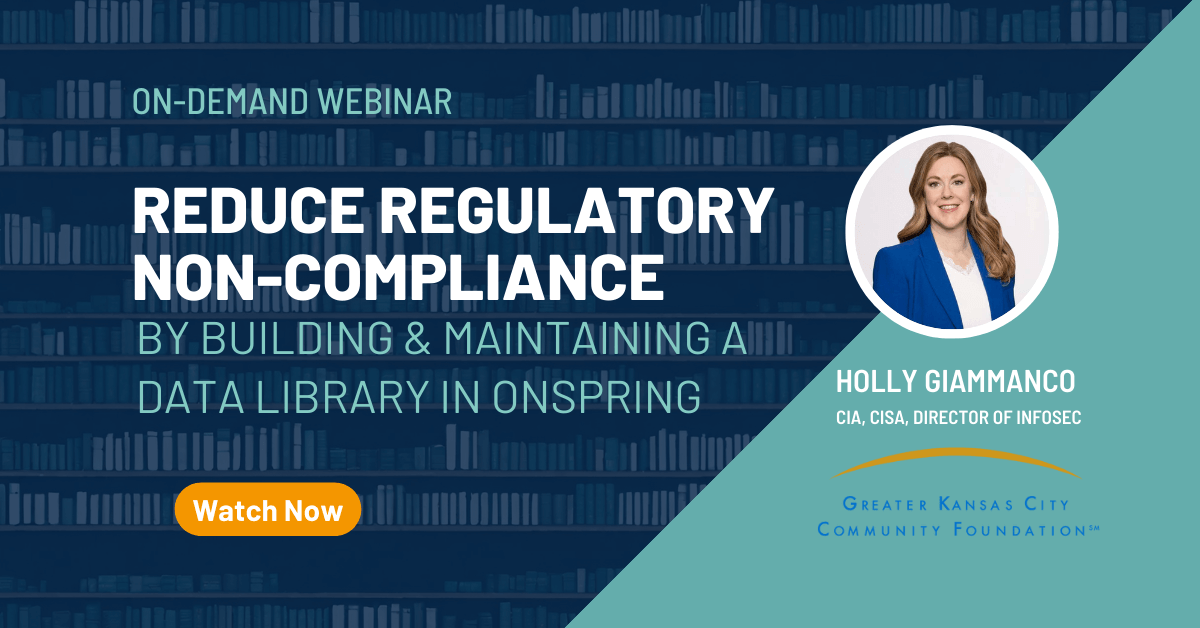3 Ways Power Up Your Program with Data Libraries
Organize and optimize your data management in Onspring
If you’ve ever been in a heated, decision-making meeting, chances are someone has said “show me the data.” In other words, prove it. And in the modern, data-driven world, organizations face the immense challenge of managing and utilizing vast amounts of data effectively, especially when making critical decisions.
This is where data libraries can help.
By harnessing the power of data libraries, particularly in Onspring, organizations can streamline data management, ensure compliance, and drive informed decision-making.
What is a data library?
A data library is a centralized repository that organizes and categorizes similar data assets, providing a single source of truth for all your data types. It acts as a comprehensive inventory, allowing you to understand what data you possess, where it resides, and how it is used.
From an automation perspective, there are two types of data libraries: informational and operational.
- Informational libraries contain lists of cataloged items, like controls or risks.
- Operational libraries apply instructions on how to perform certain tasks and standardize your processes. For example, you may have to test your firewall controls every five months, which means every five months, a test record gets created from that data library record.
Because your operational data library is consistent and repeatable, you can prove your standardization. You can show that your organization is doing what it says it does. And that’s how you gain efficiencies.
The Value of Data Libraries in Onspring
Data libraries are efficiency enablers. They empower your processes and show a higher level of maturity in your programs. While there isn’t a specific framework or regulation that requires a data library, data protection and privacy regulations certainly emphasize the importance of good data governance and clear classification. In other words: a data library.
Having a well-organized inventory of data types, assets, and data-flow activities will undoubtedly help with regulatory compliance, data governance and a multitude of other GRC practices.
Streamline Data Management
Data libraries act as centralized hubs for users to access, eliminating data silos and providing that elusive, single source of truth for all your data assets. By organizing and categorizing data types in one platform, different business units can easily access and retrieve the same information (versus relying on departmental spreadsheets), minimizing redundancy and increasing productivity.
Ensure Compliance
Maintaining regulatory compliance is critical for organizations across all industries. Onspring’s data libraries enable you to map data assets to specific regulations, ensuring adherence and simplifying the audit process.
By identifying sensitive information and implementing robust security measures, an operational data library helps minimize the risk of:
- data breaches
- fines
- reputational damage
Drive Informed Decision-making
A well-structured data library empowers organizations to make data-driven decisions. By understanding the data they possess and its relevance to business processes, companies can optimize resource allocation, improve operational efficiency, and gain a competitive advantage.
Examples of Data Libraries in Onspring
1 – Compliance Evidence Locker
A compliance evidence locker is a central source of documentation that proves your organization follows regulatory requirements. It allows internal and external auditors to access relevant information, streamlining the audit process and ensuring transparency.
This kind of data library could include:
- documentation of policies
- evidence of satisfying controls
- incident management records
- evidence of monitoring or auditing activites
- documentation of third-party assessments
2 – Risk Register
A risk register data library helps organizations catalog and assess potential risks. A risk register that’s also empowered as a data library links risks to specific processes or assets, which then allows you to identify areas that require mitigation and implement appropriate controls.
Let’s take tornadoes. You probably have some processes that would fall apart if a tornado struck. But you have other processes where tornadoes don’t matter at all. In a data library for risk, you can connect cataloged risk pieces to all of your processes, which all get mitigated with different types of controls.
While that’s running, you can reference the risk catalog and ask, “What are my most acted upon risks?” You’d know that because you’ve tied them to different processes.
This is where data libraries and automation show program maturity. You’re using all of your data to make business decisions. Maybe a tornado is really risky for your organization. Maybe you decide to move operations underground. In any case, an activated risk register enables proactive risk management and enhances overall risk visibility.
3 – Control Libraries + Operating Tests Libraries
Control libraries in Onspring provide comprehensive inventories of controls, regulatory and otherwise. And despite our digital milieu, most companies are still working in manual spreadsheets. For example, one Onspring client used to manage an Excel file full of SOC 2 controls, which were all fully mapped and assigned. Each quarter though, they would highlight their relevant data in the Excel sheet and copy & paste into a new sheet. The new sheet was then emailed to everyone to fill in for task completion. Then they would store that evidence back into a SharePoint site. The next quarter? They’d go to the big spreadsheet, copy, paste and email again.
Instead, you can categorize and link controls to specific tasks or processes in a software for everyone. This ensures consistent compliance and automates control testing, which in turn streamlines compliance programs and reduces manual effort.
Data Libraries in Onspring Optimize Data Management
Data libraries in Onspring offer a powerful solution for organizing, managing, and utilizing data effectively. By centralizing data assets, ensuring compliance, and driving informed decision-making, organizations can better steer their actions around risk to stay healthy and competitive.
Ready to see how? Schedule a demo to see how you could better organize and manage your data.
Actionable insights we think you’ll like
What is Regulatory Compliance?
Regulatory compliance is more than a legal obligation; it means fostering a culture of integrity and trust within your organization. Learn how best to adhere to industry-specific regulations, to protect your business, to build stronger relationships with stakeholders, and to create a safer environment for everyone involved.
Guide for Building an Internal Control Testing Program
This guide simplifies the creation of a robust internal control testing program, ensuring that your business remains secure and compliant. Learn how to effectively assess, test and document controls for optimal risk management.
What Does ISO Certified Mean and Why Is It Important?
Curious about what does ISO certified mean for your business? Learn how this credential can boost your company's efficiency, sustainability and customer trust. as well as the steps to achieve ISO certification.







